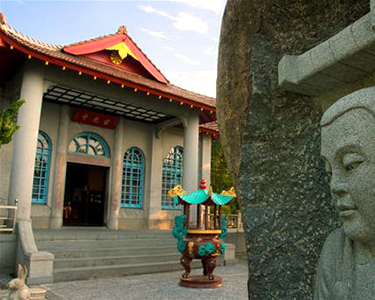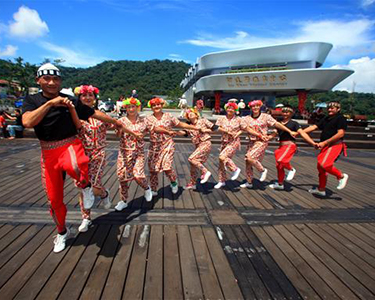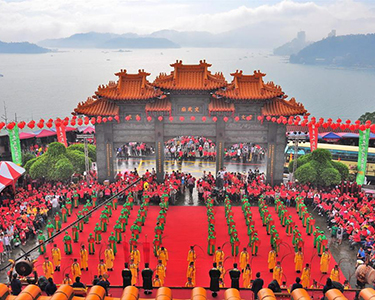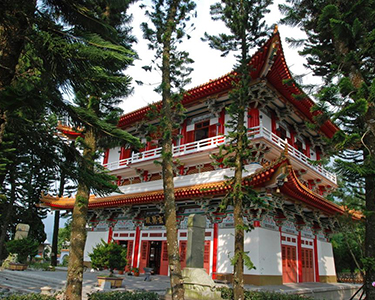Sun Moon Lake / Puli Brewery Day Tour
Itinerary
Xiangshan Visitor Center → Sun Moon Lake Boat Tour(Shueishe、Syuanguang temple、Ita
Thao) → Wenwu Temple → Sun Moon Lake Ropeway → Xuan Zang Temple → Puli Brewery
-
Xiangshan Visitor Center
The Xiangshan Visitor Center is both for tourism and administration use. The uniquely
designed building has wood-patterned exteriors and wings that stretch like human
arms embracing the earth. In addition, the two giant canopy structures, 34 meters
long and 8 meters tall each, allow people to enjoy beautiful views of the Sun Moon
Lake from the top.
-
Sun Moon Lake
Sun Moon Lake Station lies to the south east of Sun Moon Lake, the north of Ita
Thao community, and the west of Youth Activity Center. The station is 3.74 hectares
in area and is under the local government of Sun Moon village, Yuchih township.
The Ropeway incorporates water, land, and air and merges the two characteristic
tourist attractions in Taiwan. It takes about 30 minutes to drive between F.A.C.V.
and Sun Moon Lake; it is now shortened to 6.8 minutes by taking the Ropeway.
-
Shueishe
Shueishe is Sun Moon Lake's vehicle transfer area, and has a concentration of hotels.
It is also the location of a famous scenic commerce street. There is a beautiful
view from Shueishe Wharf. The perfectly designed floating wharf has not lost its
classically elegant appearance through modern design, and many activities and performances
take place here.
The Shueishe Visitor Center was completed on August 30, 2006, providing visitors
to Sun Moon Lake with a solid and complete tourist service. There is a vast, unlimited
view when looking south towards Sun Moon Lake's bay. This is the entrance and departure
point for the Shuishe Area and the Hanbi Peninsula. The Zhongxing Car Park, located
nearby, will serve Shueishe Park. The scenic commerce street to the east is Shueishe's
business circle. To the north is the transportation link to the round-the-lake highway.
Thus, Shueishe occupies a key transportation position in the Sun Moon Lake area.
-

Syuanguang temple
Syuanguang Temple, located around 2.5 kilometers from Xuanzang Temple, was built
around 1955. The relics of the Buddhist monk Xuanzang are enshrined here. Xuanzang
was a famous Tang Dynasty Buddhist monk. By order of the Tang emperor, he was sent
to India to seek Buddhist scriptures.
After more than 10 years, he returned to China, bringing back more than 650 sutras,
and together with his disciples, he translated 75 of these. He also acquired 1,335
scrolls. His efforts made great contributions to the spread of Buddhism in China.
During the war between China and Japan, a Japanese person managed to acquire a fragment
of Master Syuanzang's bones from Nanjing. It was taken to Ci'en Temple in Japan's
Saitama Prefecture, where it was enshrined. In 1952, this piece of bone was brought
to Taiwan, and after Syuanguang Temple was built at Sun Moon Lake in 1958, Master
Syuanzang's bone piece was placed there and enshrined.
This temple lies between Sun Lake and Moon Lake. Inside is a golden idol of Master
Syuanzang, above which is written, “Great National Scholar”. A wharf has been built
by the water, with its back to the mountains. Visitors can take a boat to this wharf,
where they can then ascend the stairs to visit the temple.
-

Ita Thao
Once known as Dehua Village, this is the main Thao settlement. Traditional Thao
performances and cultural exhibitions are offered here, as well as a shopping area
full of Thao atmosphere.
Ita Thao Lakeside Trail:
This 0.4-kilometer trail starts opposite the Youth Activity Center and completes
near Ita Thao Wharf. Sounds of insects and birds are incessant along this lakeshore
board walkway, and the smell of wild ginger blossoms fills the air.
The Deer Chasing Legend:
The Thao Aborigines claim that their ancestors originated from Alishan. However,
according to another legend, they originally came from the area near to Fucheng
in Tainan. Many years ago, a group of Thao hunters were hunting in the mountains
when they came upon a large, corpulent white deer. Together with their hunting dogs,
they crossed over mountains and valleys to chase this large white deer. As they
chased the deer, they went deep into the other side of the mountain. Along the journey,
they used their hunting knives to cut off pieces of bark from the trees so as to
mark their route. After chasing the deer for many days, their energy was all but
exhausted, and to their amazement, they saw a landscape of lakes and mountains unfold
before their very eyes. The white deer that they had been chasing had no way of
escape, and rushed into the middle of a lake. The hot hooves that had been on the
run were frozen by the ice cold lake waters, became stiff, rigid, and difficult
to move. After the Thao hunting ancestors caught the white deer, countless varieties
of fish were attracted to compete for its blood and internal organs. The elderly
Thao ancestors scooped up the fish varieties and were the first to carefully taste
them. Not only were the fish non-poisonous, but these shoals of fish from the lake
were extremely delicious. Only after trying out the fish did they allow the young
and strong Thao to eat them. Everyone was very pleased. Not only did the lake area
have beautiful and enticing scenery, but there was a plentiful supply of fish in
the lake. This truly was a peaceful and good location provided to the ancestors
from above. They quickly returned the way they had come, following the marks they
had made on the trees, in order to bring the rest of the community to this new place.
From that time and on, the Thao people have resided at Sun Moon Lake, which has
become their native land.
-

Wenwu Temple
During the Japanese occupation period there were two temples on the banks of the
lake: Longfeng Temple in Shueishe Village and Yihua Hall in what is now Yitashao.
But when the Japanese built their hydroelectric power plants, the water levels rose,
and the temples had to be removed. The Japanese electric company paid compensation,
and the temple managers decided to combine their resources and build a single new
temple at Songboling on the northern shore of the lake. The result was today's Wenwu
Temple.
The architecture of the temple has the palace style of northern China. It is a large
and imposing structure, with three separate halls. On the second floor of the front
hall is a shrine devoted to the First Ancestor Kaiji and the God of Literature;
the central hall is devoted to Guan Gong, the God of War, and the warrior-god Yue
Fei; the rear hall is dedicated to Confucius. This is the only Confucius Temple
in Taiwan that keeps its central door open. Temple officials say that they do this
because the temple is on the bank of Sun Moon Lake and has many tourists, so they
keep the door open for the convenience of the visitors. The bronze statue of a seated
Confucius makes this also the only Confucius temple in Taiwan that contains an image
of the sage. In addition to Confucius, there are also statues of his disciples,
Mencius and Zihsih. These three images originally came from Mainland China. They
were taken to Japan to escape the Boxer Rebellion near the end of the Qing Dynasty;
later on, they were reproduced and brought to Wunwu Temple.
Another interesting feature of the temple is the two vermillion stone lions on the
two sides of the front plaza. They were donated by Wu Huo-shih, the late chairman
of the Shin Kong Life Insurance Company, whose name meant "fire lion."
Year of Steps at Wenwu Temple
Before the round-the-lake road was built, the only way to get to Wunwu Temple was
to take a boat to the pier below the temple and climb up a very steep flight of
steps.
In early days, these steps were called the "stairway to Heaven." Completion of the
road made it far easier for travelers to reach the temple, and the steps below the
temple were gradually forgotten.
The administration recently renovated the steps. There are now 366 steps covering
the 150-meter distance, symbolizing the 366 days in a year (including an extra day
in leap year). At the step that represents the first day of each month, there is
now a platform where people can stop and rest. Information related to the 24 solar
periods is also carved into the steps, so that visitors can learn something about
China's traditional folk culture as they slowly ascend the steps. The steps are
now known as the "Year of Steps at Wunwu Temple", and make a very interesting visit.
There are also wind chimes along the steps, which are used by visitors to ask for
blessings. Their function is somewhat like that of a wishing well. Visitors first
go to Wunwu Temple and buy wind chimes for their specific animal of the Chinese
zodiac, and then have the chimes passed through incense smoke by temple workers.
Then the visitors write their names and the contents of their wishes, and go to
the top of the Year of Steps to ring the chimes, and finally go down the steps and
hang the chimes beside those steps that represent their birthdays, symbolizing the
completion of their efforts.
-
Sun Moon Lake Ropeway
The Sun Moon Lake Ropeway starts from the Formosan Aboriginal Culture Village and
ends at the Ita Thao Settlement in Sun Moon Lake for a total distance of 1.87 km.
The 7-minute ropeway ride allows visitors to view the beautiful scenery of Sun Moon
Lake from the sky.
Starting point: Formosan Aboriginal Culture Village and Sun Moon Lake
Operating hours: 10:30 ~ 16:00
-

Xuan Zang Temple
From Barawbaw (the Thao name for Sun Moon Village, also known as Riyue Village),
continue along the lake's ring road in a westerly direction. From the 4.8 kilometer
marker, you can reach the Syuentzang Temple. The front of this temple, built in
1965, faces Lalu Lake, while the rear faces Qinglong Mountain. A fengshui master
has claimed that the temple occupies a precious land where a "green dragon plays
with a pearl". The temple is divided into two levels, one where the remains of the
monk Xuanzang are worshipped, and the other, where the golden Sakyamuni Buddha is
worshipped. Xuanzang was an eminent Tang Dynasty monk who was ordered by the Tang
emperor to go to India and bring back the Buddhist scriptures. It was more than
10 years before he returned to China, bringing back over 650 sutras. Together with
his disciples, he translated 75 sections, producing 1335 volumes of scripture, and
making a great contribution to the development of Buddhism in China.
During World War II, the Japanese stole Xuanzang's remains from Nanjing. They were
enshrined and worshipped at the Jion-ji Temple in Japan's Saitama Prefecture. In
1955, the remains were taken to Taiwan, where they were enshrined and worshipped
at Xuanguang Temple, located next to Sun Moon Lake. After Xuanzang Temple was completed
in November 1965, the remains were relocated there.
Syuentzang Temple is built in the Tang Dynasty architectural style, and the square
bricks on the ground create a smooth and unadorned appearance. Inside the temple
is a horizontal board with the words “national treasure”, written by President Chiang
Kai-shek. On the outer walls of the temple are carvings of Master Xuanzang during
his travels to the west. There are also three stele inscriptions. The left stele
commemorates the friendship between the Chinese and Japanese. The middle provides
a life history of Master Xuanzang. The right stele commemorates friendly Buddhist
exchanges between the Chinese and Japanese. In addition, there are two revered stone
statues in front of the door. In front of the temple is a large drum, and when ascending
the steps, one can see a bell and mallet used to wake people.
-
Puli Brewery
Puli Brewery mainly produced glutinous rice wine, rice wine, taibai liquor, and
sake in the early years after Taiwan's Restoration. Production volume, however,
was not very high and most of the wines were sold to the local residents. After
repeated experimentation using natural Ailan spring waters, the Brewery finally
achieved a fine brew of shaoxing wine in 1952 that was finely received by various
customers. Hence, the Brewery began to gradually reduce the production of cheaper
wines and shifted its focus to mass production of shaoxing wine in 1966. The Brewery
also faced stiff competition from imported wines, but its Ailan White Liquor proved
to be a winning hit in 1995. Puli Brewery also started working with local industries,
public administration, schools, research institutes, and other agencies in order
to promote a healthy wine culture and diversify its business operations.
The Feature of Taiwan Taxi
- Professional driver-guides with an average experience of 5 years.
- GPS dispatch + 3G (GPS, GPRS, GIS) taxi service + 24-hour monitoring service for
riding safety.
- Largest brand/number of taxi (around 6,000 taxis) available for service and largest
scale of operation with service provided in Taiwan.
- SOS emergency assistance.
Price Includes
- Chinese-Speaking driver-guide service.
- Roundtrip Taipei hotel/downtown area transfer.
- Price is based on distance by per car and maximum seating capacity for 4 passengers.
- Executing compulsory insurance up to NT$ 16 million/p.car. And each passenger will
be insured accidental insurance of NT$ 2 million and accidental medical insurance
of NT$ 200 thousand.
Extra Cost Items
- Meal plan, souvenir, ★admission fee and gratuity ($20-30/p.car recommended)
- Extended Hours(if need): $30/p.hour/p.car
- English/Japanese-Speaking driver-guide can be requested. ($40/p.car)
- Escort Tour Guide service : $45/p.car
- All rates are not valid during the 2023 CHINESE NEW YEAR. Price will be increased $45 for each tour period 20Jan-28Jan 2023.
Important Notes
- Please provide your booking# and passport copy when you get in taxi.
- Majestic Vacations reserves the right to amend itinerary and price.
- Taiwan Taxi reserves the right to substitute, alter or modify the tour if any unexpected
and unforeseen conditions beyond our control preventing the completion of such.
Conditions can include weather, traffic jam, traffic accident and car equipment
problems.
Cancellation Policy
- 100% penalty ,7 days or less days prior to departure.
- $30 penalty up to 8 days before prior to departure.
Back Order Online